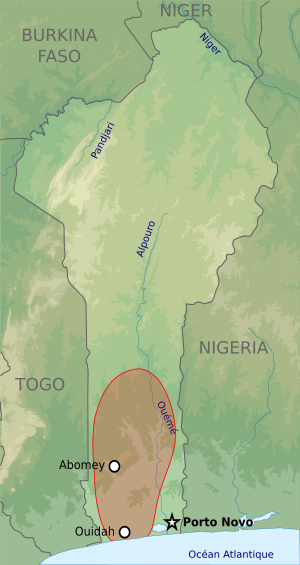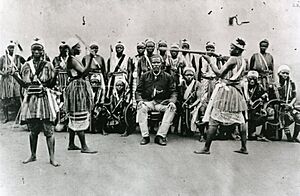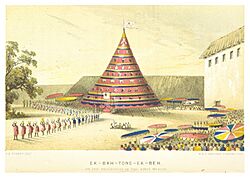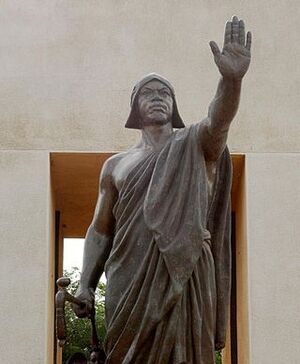History of the Kingdom of Dahomey facts for kids
The Kingdom of Dahomey was a powerful kingdom in West Africa, lasting from about 1600 to 1904. It was located in what is now the country of Benin. It became very strong in the 1720s by taking over important coastal cities like Allada and Whydah.
For a long time, Dahomey was a big part of the Atlantic Slave Trade. But in 1852, the British navy blocked its ports to stop this trade. War with the French started in 1892, and France took control of the kingdom in 1894. The French officially ended the kingdom in 1900. However, the royal families and leaders of Dahomey continued to be important in politics, even after Benin became independent in 1960.
Contents
History of Dahomey
Life Before Dahomey Kingdom
Before the Kingdom of Dahomey was formed, the area was home to many small tribes called the Gedevi. This region was quite poor because it didn't have many resources or access to important trade routes.
To the east, the powerful Oyo Empire (in modern-day Nigeria) had some control over the local tribes. To the south, two important kingdoms, Allada and Whydah, controlled the Atlantic coast. European traders, like the Portuguese, started trading with the coastal areas in the 15th century. Big trade began in 1533 when the Portuguese signed a deal with the city of Grand-Popo.
How Dahomey Was Founded
There are many folk stories about how the Kingdom of Dahomey began. Most experts believe these stories were made up or exaggerated in the 1700s to make the Dahomey kings seem more legitimate. So, they might not be completely true.
The most common story says the kingdom started with a prince named Agassu from the Fon people in the city of Tado. He tried to become king but failed, so he took over the city of Allada instead.
Around 1600, two (or sometimes three) princes from Agassu's family fought over who would rule Allada. They decided that both princes would leave and start new kingdoms. Teagbanlin went south and founded Porto-Novo, while Do-Aklin went north to the Abomey plateau. (Porto-Novo and Dahomey remained rivals for a long time.)
Do-Aklin's son, Dakodonu, was allowed to settle in the Abomey area by the Gedevi chiefs. But when Dakodonu asked a chief named Dan for more land, things turned bad. The chief sarcastically replied, "Should I open up my belly and build you a house in it?" Dakodonu immediately killed Dan and ordered his new palace to be built on that spot. The kingdom's name, Dahomey, is said to come from this event: Dan (chief), xo (Belly), me (Inside of).
Dahomey's Rise and Growth (1600-1740)
| Kingdom of Dahomey Timeline | |
|---|---|
| c. 1600 AD | Dakodonou starts the palace in Abomey. |
| 1724-1727 AD | Agaja conquers Allada and Whydah. |
| 1730 AD | Dahomey loses war with the Oyo Empire and becomes a tributary. |
| 1823 AD | King Ghezo defeats Oyo and ends Dahomey's tributary status. |
| 1851-1852 AD | British block Dahomey ports, stopping the slave trade. |
| 1892-1894 AD | Second Franco-Dahomean War leads to French control. |
| 1900 AD | French exile Agoli-agbo, officially ending the kingdom. |
Oral stories say the empire was started around 1600 by the Fon people. The Palace in Abomey was built in the early 1600s. Houegbadja (c.1645-1685) is often seen as the first important king. He built the Royal Palaces of Abomey and began taking over towns outside Abomey.
At the same time, the slave trade grew in coastal areas like Whydah and Allada, with traders from Portugal, the Netherlands, and Britain. The Dahomey Kingdom became known to European traders as a major source of enslaved people.
King Agaja, Houegbadja's grandson, became king in 1718 and greatly expanded Dahomey. By 1720, King Agaja stopped obeying Allada and increased his military actions. In 1724, Agaja helped with a power struggle in Allada, but then turned his army on Allada and took over the city. He moved his capital from Abomey to Allada.
In 1727, Agaja took over the city of Whydah, becoming the main power on a large part of the coast. In 1729, Agaja started a war with the Oyo Empire. During this war, the royal family of Whydah tried to regain control, forcing Agaja to fight to reclaim the city. He moved much of his army, with many women dressed as male warriors in the back. This might have been the start of the famous Dahomey Amazons. The Whydah royal family thought Dahomey's army was weak, but seeing such a large force, they fled.
In 1730, the war with Oyo ended. Dahomey kept control of its lands but had to pay tribute to the Oyo Empire. By the end of Agaja's rule, the Kingdom of Dahomey controlled a large area, especially the important coastal cities involved in the slave trade. Agaja also set up much of the kingdom's government and started the important Annual Customs, or Xwetanu.
Dahomey as a Regional Power (1740-1852)
After Agaja died in 1740, the kingdom faced political struggles, mostly within the palace. It also became more deeply involved in the slave trade. After Agaja's death, there was a big fight over who would be king. The chosen heir was passed over for Tegbessou (who ruled from 1740 to 1774).
Tegbessou moved the capital back to Abomey. He had to deal with different powerful groups in the kingdom and keep the conquered areas loyal. At the same time, the empire continued to raid for captives throughout the region, becoming a major supplier for the Atlantic slave trade.
In the late 1700s, Oyo pressured Dahomey to reduce its slave trade to protect its own trade. Dahomey agreed to limit some of it. However, even with this, the empire was a major player in the slave trade, providing up to 20% of the total trade. This trade brought the king most of his money.
In 1818, King Ghezo (ruled 1818–1858) took the throne by force, replacing his older brother Adandozan. A key reason for Ghezo's rise was the help he got from Francisco Félix de Sousa, a well-known Brazilian slave trader in Whydah. Because of this, Ghezo made de Sousa the chacha, or trade leader, in Whydah. This gave de Sousa much more power and money. (The title chacha is still an important honorary position in Whydah today.) In 1823, Ghezo led his armies against Oyo. This time, he was able to end Dahomey's tribute payments and permanently weaken Oyo.
Stopping the Slave Trade (1852-1880)
Two big changes happened in the 1840s and 1850s that greatly affected Dahomey's politics. First, the British government pressured Dahomey to end the slave trade. This was happening during a time when the British were expanding their control in the region. Britain sent many diplomats to King Ghezo to convince him to stop the slave trade. However, Ghezo refused, worried about the political problems this would cause.
Second, the city of Abeokuta was founded in 1825. It grew into a safe place for people escaping Dahomey's slave raids. In 1844, Dahomey and Abeokuta went to war, and Abeokuta won. Other conflicts in the early 1850s further challenged Dahomey's economic control in the region.
Inside Dahomey, these pressures led to changes. Ghezo rejected British demands to end the slave trade. But at the same time, he started greatly expanding the palm oil trade as a new way to make money. Politically, the debate was between two groups: the Elephant and the Fly. The Elephant group, connected to Ghezo, powerful leaders, and slave traders like the De Sousa family, wanted to continue the slave trade and resist British pressure. The Fly group, made up of palm oil producers and some chiefs, supported working with Abeokuta and the British to grow the palm oil trade. These two groups had many tense discussions about Dahomey's future during the war and policy meetings at the Annual Customs.
In 1851–1852, the British navy blocked Dahomey's ports to force them to stop the slave trade. In January 1852, Ghezo agreed to a treaty with the British, ending the export of enslaved people from Dahomey. In the same year and the next, Ghezo stopped large military campaigns. However, political pressure led to the slave trade and large military actions starting again in 1857 and 1858. Ghezo was killed by a sniper linked to Abeokuta, and a big war between the two states restarted in 1864. This war also ended with Abeokuta winning. As a result, the slave trade could not return to its earlier levels. The power of slave traders in the empire decreased, and the palm oil trade became a more important part of the economy.
European Colonization (1880-1900)
Dahomey's control of key coastal cities made the area very important during the European scramble for Africa. In 1878, Dahomey agreed to let the French make the city of Cotonou a protectorate. However, the King of Dahomey was still allowed to collect taxes there. In 1883, the French got similar agreements for Porto-Novo, a long-time rival of Dahomey on the coast.
In 1889, King Glele died, and his son Béhanzin became king. Béhanzin immediately became very unfriendly towards the French during negotiations. He rejected the treaty that gave France control over Cotonou and began raiding French areas. The tension grew when Béhanzin started conducting slave raids in French protectorates along the coast, like Grand-Popo, in 1891. That year, the French military decided that a takeover was the only solution. General Alfred-Amédée Dodds was put in charge of the operation, which began in 1892.
The Franco-Dahomean War lasted from 1892 until January 1894. Dodds captured the city of Abomey on January 15 and King Béhanzin on January 25. A notable event during the war was the defeat of the Dahomey Amazons in November 1892. Dodds named Agoli-agbo the new king of Dahomey, mostly because he seemed easy to control. Béhanzin was sent away to French lands in the Caribbean.
The French began changing how the Kingdom of Dahomey was run. In 1899, the French introduced a new tax that was very unpopular. Agoli-Agbo opposed this tax, causing serious political problems. As a result, on February 17, 1900, the French removed Agoli-Agbo from power and officially ended the Kingdom of Dahomey. However, the French did bring together many important members of the kingdom to serve as chiefs of local areas called cantons. French Dahomey included the former Kingdom of Dahomey, Porto-Novo, and an area to the north with loose tribal control.
Agoli-Agbo remained in exile from 1900 until 1910. The French administration then allowed him to return to the area because of his important role in Fon ancestor worship and ceremonies. He was not allowed to live in Abomey or travel freely, but he could visit Abomey to perform ceremonial duties during the Annual Customs.
Dahomey's Lasting Influence
The French ruled the area as French Dahomey from 1900 until 1960, when the country became independent and was named the Republic of Dahomey. In 1975, the country's name was changed to Benin. The King of Dahomey remains an important ceremonial position, continuing through both French rule and independence. Since 2000, there has been a disagreement over who should hold the position, with Agoli-Agbo III and Houedogni Behanzin both claiming the throne.
The political and economic structures of Dahomey have remained very important in independent Dahomey and Benin. One of the main leaders who controlled politics in the country from 1960 to 1972 was Justin Ahomadégbé-Tomêtin. He was head of state twice and gained much political power because of his connection to the royal family of Dahomey. The descendants of Francisco Félix de Sousa are still very important political leaders in Benin today. These include Colonel Paul-Émile de Souza (Benin's head of state 1969–1970) and Isidore de Souza (President of the National Assembly of Benin 1990–1991).
Kojo Tovalou Houénou (1887–1936) claimed to be a prince of Dahomey, though he lived most of his life in France. He became a major critic of the French colonial empire. He founded the Ligue Universelle pour la Défense de la Race Noire (Universal League for the Defense of the Black Race). This group pushed for Africans to be recognized as full citizens of the French state.





